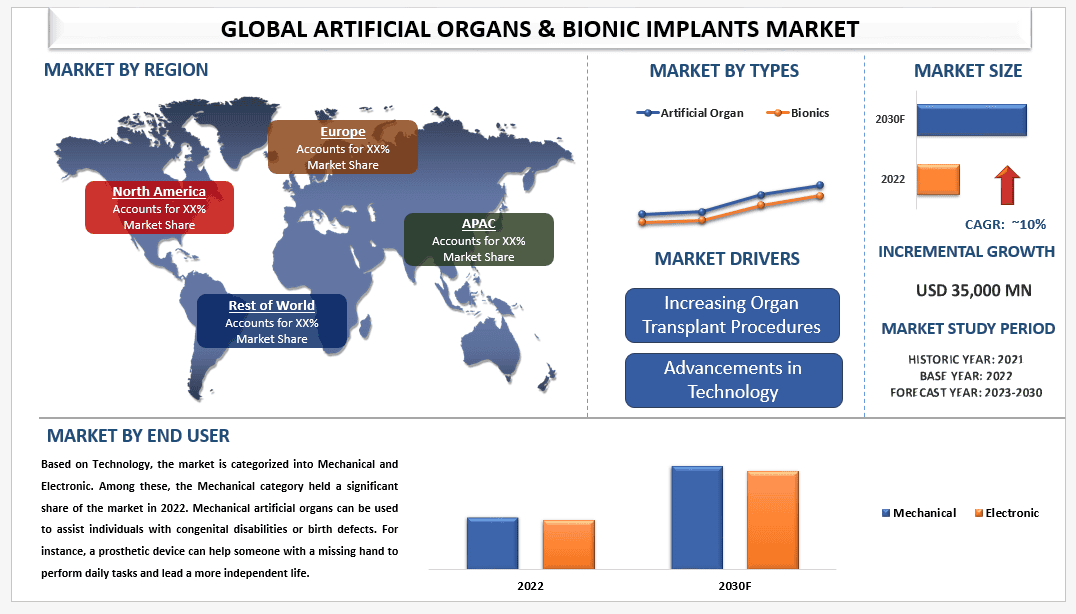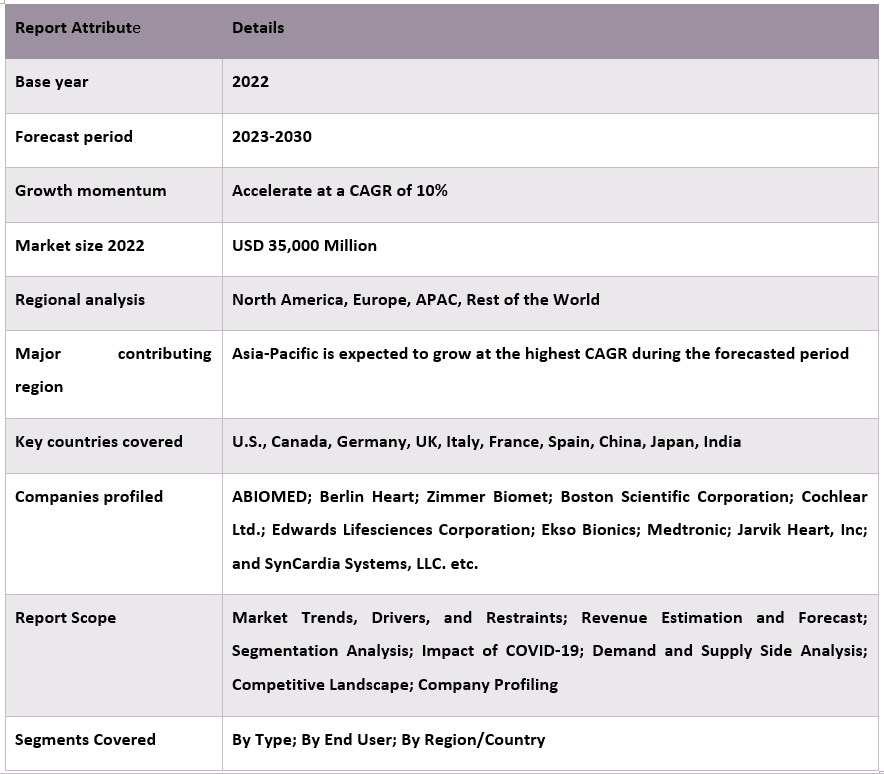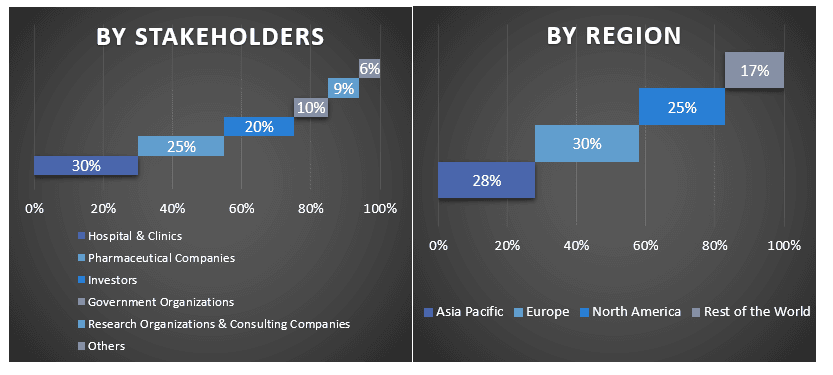- Trang chủ
- Về chúng tôi
- Ngành
- Dịch vụ
- Đọc
- Liên hệ với chúng tôi
Thị trường nội tạng nhân tạo & cấy ghép sinh học: Phân tích hiện tại và Dự báo (2023-2030)
Nhấn mạnh vào Loại (Cơ quan nhân tạo và Cảm biến Sinh học); Công nghệ (Cơ khí và Điện tử); và Khu vực/Quốc gia

Thị trường nội tạng nhân tạo và cấy ghép Bionic được định giá 35.000 triệu USD vào năm 2022 và dự kiến sẽ tăng trưởng với tốc độ CAGR khoảng 6% từ năm 2023-2030. Nội tạng nhân tạo và cấy ghép bionic là những công nghệ mang tính cách mạng nhằm khôi phục hoặc tăng cường chức năng của một cơ quan hoặc hệ thống cụ thể trong cơ thể con người. Những tiến bộ này có khả năng cải thiện đáng kể chất lượng cuộc sống cho những cá nhân bị suy nội tạng, khuyết tật hoặc mắc các bệnh thoái hóa. Ví dụ: theo dữ liệu của Mạng lưới Cung cấp & Ghép tạng, năm 2021, 41.354 ca ghép tạng đã được thực hiện ở Hoa Kỳ, tăng 5,9% so với năm 2020. Ba loại tạng được ghép phổ biến nhất đều đạt kỷ lục về số lượng hàng năm. Tổng cộng có 24.669 ca ghép thận, 9.236 ca ghép gan và 3.817 ca ghép tim. Nhu cầu về nội tạng nhân tạo và cấy ghép bionic phát sinh từ nhu cầu thay thế hoặc hỗ trợ chức năng của các cơ quan bị tổn thương hoặc không còn chức năng. Sự gia tăng tỷ lệ mắc các bệnh mãn tính, tiến bộ công nghệ, dân số già, nhận thức ngày càng tăng và các chính sách hỗ trợ đã cùng nhau đóng vai trò là động lực quan trọng cho thị trường Nội tạng nhân tạo & Cấy ghép Bionic.
Một số công ty lớn hoạt động trên thị trường bao gồm ABIOMED; Berlin Heart; Zimmer Biomet; Boston Scientific Corporation; Cochlear Ltd.; Edwards Lifesciences Corporation; Ekso Bionics; Medtronic; Jarvik Heart, Inc; và SynCardia Systems, LLC, v.v.
Thông tin chi tiết được trình bày trong Báo cáo
“Trong số các Loại, phân khúc nội tạng nhân tạo dự kiến sẽ chiếm thị phần đáng kể trong giai đoạn dự báo.”
Dựa trên Loại, thị trường được phân khúc thành nội tạng nhân tạo và Bionics. Danh mục nội tạng nhân tạo chiếm thị phần đáng kể trên thị trường vào năm 2022. Phân khúc này đang tăng trưởng chủ yếu do nhu cầu ngày càng tăng đối với việc ghép thận, tim, phổi và gan. Ví dụ: theo dữ liệu của Mạng lưới Cung cấp & Ghép tạng, có tổng cộng 24.669 ca ghép thận, 9.236 ca ghép gan và 3.817 ca ghép tim ở Hoa Kỳ. Ở Hoa Kỳ, thời gian chờ trung bình để ghép thận là khoảng 5 năm. Do đó, các nhà sản xuất đã có động lực giải quyết thách thức đáp ứng nhu cầu chưa được đáp ứng bằng cách phát triển các giải pháp sáng tạo như phổi sinh học, tuyến tụy nhân tạo và thận nhân tạo đeo được.
“Trong số các Công nghệ, phân khúc Cơ khí chiếm thị phần đáng kể vào năm 2022.”
Dựa trên Công nghệ, thị trường được phân loại thành Cơ khí và Điện tử. Trong số đó, danh mục Cơ khí chiếm thị phần đáng kể trên thị trường vào năm 2022. Nội tạng nhân tạo cơ học có thể được sử dụng để hỗ trợ những người bị dị tật bẩm sinh hoặc khuyết tật khi sinh. Ví dụ, một thiết bị giả có thể giúp một người bị mất tay thực hiện các công việc hàng ngày và có một cuộc sống độc lập hơn.
Phạm vi Báo cáo Thị trường Nội tạng nhân tạo & Cấy ghép Bionic

“Châu Á Thái Bình Dương dự kiến sẽ tăng trưởng với tốc độ CAGR cao nhất Thị trường Nội tạng nhân tạo & Cấy ghép Bionic trong giai đoạn dự báo.”
Khu vực APAC đã chứng kiến sự gia tăng tỷ lệ mắc và phổ biến của các bệnh mãn tính, thúc đẩy sự quan tâm ngày càng tăng từ các nhà nghiên cứu, chuyên gia chăm sóc sức khỏe và các công ty dược phẩm. Cùng với đó, các yếu tố như số lượng ca ghép tạng ngày càng tăng, nâng cao nhận thức giữa các bác sĩ lâm sàng và những thay đổi về nhân khẩu học có thể đã góp phần vào việc xác định các trường hợp chưa được chẩn đoán trước đây. Do đó, sự gia tăng này đã làm nổi bật sự cần thiết phải cải thiện sự hiểu biết, các lựa chọn điều trị và tiềm năng thị trường trong khu vực.
Mục lục
Phương Pháp Nghiên Cứu cho Phân Tích Thị Trường Cơ Quan Nhân Tạo & Cấy Ghép Sinh Học (2023-2030)
Phân tích thị trường lịch sử, ước tính thị trường hiện tại và dự báo thị trường tương lai của Thị trường Cơ quan Nhân tạo & Cấy Ghép Sinh học toàn cầu là ba bước chính được thực hiện để tạo và phân tích việc áp dụng Máy đo nồng độ oxy trong máu ngoại vi ở các khu vực lớn trên toàn cầu. Nghiên cứu thứ cấp chuyên sâu đã được tiến hành để thu thập các số liệu thị trường lịch sử và ước tính quy mô thị trường hiện tại. Thứ hai, để xác thực những hiểu biết này, nhiều phát hiện và giả định đã được xem xét. Hơn nữa, các cuộc phỏng vấn sơ cấp chuyên sâu cũng đã được thực hiện với các chuyên gia trong ngành trên toàn chuỗi giá trị của Thị trường Cơ quan Nhân tạo & Cấy Ghép Sinh học toàn cầu. Sau khi giả định và xác thực các số liệu thị trường thông qua các cuộc phỏng vấn sơ cấp, chúng tôi đã sử dụng phương pháp tiếp cận từ trên xuống/từ dưới lên để dự báo quy mô thị trường hoàn chỉnh. Sau đó, các phương pháp phân tích thị trường và phương pháp tam giác dữ liệu đã được áp dụng để ước tính và phân tích quy mô thị trường của các phân khúc và phân đoạn phụ của ngành liên quan đến. Phương pháp chi tiết được giải thích dưới đây:
Phân Tích Quy Mô Thị Trường Lịch Sử
Bước 1: Nghiên Cứu Chuyên Sâu về Các Nguồn Thứ Cấp:
Nghiên cứu thứ cấp chi tiết đã được tiến hành để có được quy mô thị trường lịch sử của Thị trường Cơ quan Nhân tạo & Cấy Ghép Sinh học thông qua các nguồn nội bộ của công ty như báo cáo thường niên & báo cáo tài chính, thuyết trình hiệu suất, thông cáo báo chí, v.v. và các nguồn bên ngoài bao gồm tạp chí, tin tức & bài viết, ấn phẩm của chính phủ, ấn phẩm của đối thủ cạnh tranh, báo cáo ngành, cơ sở dữ liệu của bên thứ ba và các ấn phẩm đáng tin cậy khác.
Bước 2: Phân Khúc Thị Trường:
Sau khi có được quy mô thị trường lịch sử của Thị trường Cơ quan Nhân tạo & Cấy Ghép Sinh học, chúng tôi đã tiến hành một phân tích thứ cấp chi tiết để thu thập thông tin chi tiết về thị trường lịch sử và chia sẻ cho các phân khúc & phân đoạn phụ khác nhau cho các khu vực lớn. Các phân khúc chính được bao gồm trong báo cáo là phương thức, loại dịch vụ và chuyên gia. Phân tích cấp quốc gia sâu hơn đã được tiến hành để đánh giá việc áp dụng tổng thể các mô hình thử nghiệm trong khu vực đó.
Bước 3: Phân Tích Yếu Tố:
Sau khi có được quy mô thị trường lịch sử của các phân khúc và phân đoạn phụ khác nhau, chúng tôi đã tiến hành phân tích yếu tố chi tiết để ước tính quy mô thị trường hiện tại của Thị trường Cơ quan Nhân tạo & Cấy Ghép Sinh học. Hơn nữa, chúng tôi đã tiến hành phân tích yếu tố bằng cách sử dụng các biến phụ thuộc và độc lập như phương thức, loại dịch vụ và chuyên gia của Thị trường Cơ quan Nhân tạo & Cấy Ghép Sinh học. Một phân tích kỹ lưỡng đã được tiến hành cho các kịch bản cung và cầu xem xét các quan hệ đối tác hàng đầu, sáp nhập và mua lại, mở rộng kinh doanh và ra mắt sản phẩm trong lĩnh vực Thị trường Cơ quan Nhân tạo & Cấy Ghép Sinh học trên toàn cầu.
Ước Tính & Dự Báo Quy Mô Thị Trường Hiện Tại
Xác định Quy mô Thị trường Hiện tại: Dựa trên những hiểu biết sâu sắc có thể hành động từ 3 bước trên, chúng tôi đã đưa ra quy mô thị trường hiện tại, những người chơi chính trong Thị trường Cơ quan Nhân tạo & Cấy Ghép Sinh học toàn cầu và thị phần của các phân khúc. Tất cả các phần trăm cổ phần cần thiết và các phân tích thị trường đã được xác định bằng cách sử dụng phương pháp thứ cấp nói trên và đã được xác minh thông qua các cuộc phỏng vấn sơ cấp.
Ước tính & Dự báo: Để ước tính và dự báo thị trường, trọng số đã được gán cho các yếu tố khác nhau bao gồm các động lực & xu hướng, hạn chế và cơ hội có sẵn cho các bên liên quan. Sau khi phân tích các yếu tố này, các kỹ thuật dự báo phù hợp, tức là phương pháp tiếp cận từ trên xuống/từ dưới lên đã được áp dụng để đưa ra dự báo thị trường cho năm 2030 cho các phân khúc và phân đoạn phụ khác nhau trên các thị trường lớn trên toàn cầu. Phương pháp nghiên cứu được áp dụng để ước tính quy mô thị trường bao gồm:
- Quy mô thị trường của ngành, về mặt doanh thu (USD) và tỷ lệ chấp nhận của Thị trường Cơ quan Nhân tạo & Cấy Ghép Sinh học trên các thị trường lớn trong nước
- Tất cả các phần trăm cổ phần, phân tích và phân chia các phân khúc và phân đoạn phụ của thị trường
- Những người chơi chính trong Thị trường Cơ quan Nhân tạo & Cấy Ghép Sinh học toàn cầu về các sản phẩm được cung cấp. Ngoài ra, các chiến lược tăng trưởng được các nhà chơi này áp dụng để cạnh tranh trên thị trường đang phát triển nhanh chóng
Xác Thực Quy Mô và Thị Phần Thị Trường
Nghiên cứu Sơ cấp: Các cuộc phỏng vấn chuyên sâu đã được thực hiện với Những Người Dẫn Đầu Ý Kiến Quan Trọng (KOL) bao gồm các Giám Đốc Điều Hành Cấp Cao (CXO/VP, Trưởng Phòng Bán Hàng, Trưởng Phòng Marketing, Trưởng Phòng Vận Hành, Trưởng Khu Vực, Trưởng Đại Diện Quốc Gia, v.v.) trên khắp các khu vực lớn. Các phát hiện nghiên cứu sơ cấp sau đó đã được tóm tắt và phân tích thống kê đã được thực hiện để chứng minh giả thuyết đã nêu. Đầu vào từ nghiên cứu sơ cấp đã được hợp nhất với các phát hiện thứ cấp, do đó biến thông tin thành những hiểu biết sâu sắc có thể hành động.
Phân Chia Những Người Tham Gia Sơ Cấp ở Các Khu Vực Khác Nhau

Kỹ Thuật Thị Trường
Kỹ thuật tam giác dữ liệu đã được sử dụng để hoàn thành việc ước tính thị trường tổng thể và đưa ra các số liệu thống kê chính xác cho từng phân khúc và phân đoạn phụ của Thị trường Cơ quan Nhân tạo & Cấy Ghép Sinh học toàn cầu. dữ liệu đã được chia thành nhiều phân khúc & phân đoạn phụ sau khi nghiên cứu các thông số và xu hướng khác nhau trong các lĩnh vực phương thức, loại dịch vụ và chuyên gia trong Thị trường Cơ quan Nhân tạo & Cấy Ghép Sinh học toàn cầu.
Mục tiêu chính của Nghiên cứu Thị trường Cơ quan Nhân tạo & Cấy Ghép Sinh học Toàn cầu
Các xu hướng thị trường hiện tại & tương lai của Thị trường Cơ quan Nhân tạo & Cấy Ghép Sinh học toàn cầu đã được xác định chính xác trong nghiên cứu. Các nhà đầu tư có thể có được những hiểu biết sâu sắc về chiến lược để dựa trên sự thận trọng của họ đối với các khoản đầu tư dựa trên phân tích định tính và định lượng được thực hiện trong nghiên cứu. Các xu hướng thị trường hiện tại và tương lai xác định sức hấp dẫn tổng thể của thị trường ở cấp khu vực, cung cấp một nền tảng cho người tham gia công nghiệp khai thác thị trường chưa được khai thác để hưởng lợi từ lợi thế của người đi đầu. Các mục tiêu định lượng khác của các nghiên cứu bao gồm:
- Phân tích quy mô thị trường hiện tại và dự báo của Thị trường Cơ quan Nhân tạo & Cấy Ghép Sinh học về giá trị (USD). Ngoài ra, hãy phân tích quy mô thị trường hiện tại và dự báo của các phân khúc và phân đoạn phụ khác nhau
- Các phân khúc trong nghiên cứu bao gồm các lĩnh vực phương thức, loại dịch vụ và chuyên gia.
- Xác định và phân tích khuôn khổ pháp lý cho ngành Máy đo nồng độ oxy trong máu ngoại vi
- Phân tích chuỗi giá trị liên quan đến sự hiện diện của các trung gian khác nhau, cùng với việc phân tích hành vi của khách hàng và đối thủ cạnh tranh của ngành
- Phân tích quy mô thị trường hiện tại và dự báo của Thị trường Cơ quan Nhân tạo & Cấy Ghép Sinh học cho khu vực lớn
- Các quốc gia lớn của các khu vực được nghiên cứu trong báo cáo bao gồm Châu Á Thái Bình Dương, Châu Âu, Bắc Mỹ và Phần Còn Lại của Thế giới
- Hồ sơ công ty của Thị trường Cơ quan Nhân tạo & Cấy Ghép Sinh học và các chiến lược tăng trưởng được các nhà chơi thị trường áp dụng để duy trì trên thị trường đang phát triển nhanh chóng
- Phân tích sâu sắc cấp khu vực của ngành
Câu hỏi thường gặp Câu hỏi thường gặp
Hỏi 1: Quy mô thị trường hiện tại và tiềm năng tăng trưởng của Thị trường Cơ quan Nhân tạo & Bộ phận Cấy ghép Sinh học là gì?
Q2: Đâu là những yếu tố thúc đẩy sự tăng trưởng của Thị trường Cơ quan Nhân tạo & Bộ phận Cấy ghép Sinh học?
Q3: Các công nghệ và xu hướng mới nổi trong Thị trường Cơ quan Nhân tạo & Thiết bị cấy ghép sinh học là gì?
Q4: Khu vực nào sẽ thống trị Thị trường Tạng nhân tạo & Cấy ghép sinh học?
Q5: Ai là những người chơi chủ chốt hoạt động trong Thị trường Cơ quan Nhân tạo & Thiết bị Cấy ghép Sinh học?
Liên quan Báo cáo
Khách hàng đã mua mặt hàng này cũng đã mua










